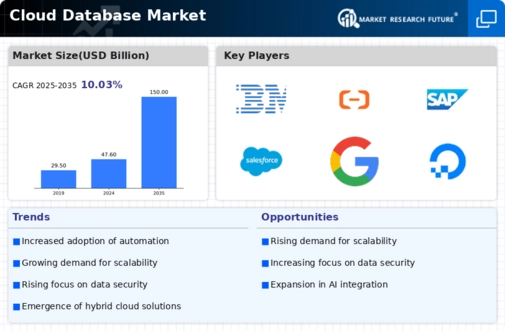Top Industry Leaders in the Cloud Database Market

Cloud Database Market: Dive into the Latest News and Updates
In the era of digital transformation, businesses are ditching clunky on-premises data silos and embracing the agility and scalability of the cloud. At the heart of this revolution lies the Cloud Database Market, a dynamic space where data storage and management transform,
Some of Cloud Database Companies Listed Below:
- Google Inc. (US)
- com (US)
- Oracle (US)
- Microsoft (US)
- IBM (US)
- com Inc. (US)
- Rackspace Inc. (US)
- SAP AG (Germany)
- CenturyLink (US)
- CSC (Computer Science Corporation) (US)
Strategies Fueling Growth:
- Hybrid and Multi-Cloud Support: Offering flexible deployment options across diverse cloud platforms and even on-premises environments allows businesses to leverage existing infrastructure and migrate data at their own pace.
- Database as a Service (DBaaS): Providing fully managed database solutions with automation, patching, and scaling capabilities simplifies data management and reduces operational overhead for businesses.
- Integration and Ecosystem: Seamless integration with existing platforms, tools, and data analytics solutions facilitates workflows and empowers businesses to unlock insights from their data.
- Security and Compliance: Robust security features, data encryption, and compliance with regulations like GDPR and HIPAA build trust and open doors to data-sensitive industries.
Market Share Decoding: Key Factors to Consider:
- Functionality and Feature Set: Platforms offering diverse database types (relational, NoSQL, graph), advanced features like geospatial capabilities or in-memory options, and integration with analytics tools cater to varied data management needs.
- Scalability and Performance: Ability to handle large data volumes, scale seamlessly with business growth, and deliver high performance is crucial for mission-critical applications.
- Pricing and Cost-Effectiveness: Flexible pricing models, pay-as-you-go options, and tiered plans based on storage, usage, or performance make cloud databases accessible to businesses of all sizes and budgets.
- Ease of Use and Management: User-friendly interfaces, automated features, and readily available documentation simplify database administration and reduce the need for in-house expertise.
New and Emerging Stars: Illuminating the Cloud Database Path:
- Serverless Databases: Startups like Cockroach Labs and Fauna develop serverless database solutions that eliminate infrastructure management, automate scaling, and simplify data management for modern applications.
- Edge Computing and Distributed Databases: Companies like C3.ai and Couchbase explore edge computing-enabled databases, bringing data storage and processing closer to the edge of networks for real-time applications and improved performance.
- AI-Powered Data Management: Startups like Aiven and Anomalo integrate AI into their database solutions for automated data optimization, anomaly detection, and security threat mitigation.
Investment Trends: Where the Cloud Database Dollars Flow:
- Next-Generation Cloud Native Databases: Investors are backing companies developing cloud-native databases built from the ground up for the cloud, offering unmatched scalability, flexibility, and cost-efficiency.
- AI and Machine Learning Integration: Startups incorporating AI and machine learning into their cloud database offerings attract significant investment to support intelligent data management and analytics.
Latest Company Updates:
October 27, 2023:
- Amazon Aurora expands capabilities with serverless option: This update allows developers to pay only for the compute resources they use, further optimizing cost efficiency.
- Microsoft Azure Cosmos DB gains native integration with Azure Arc: This enables consistent cloud database management across hybrid and multi-cloud environments.
November 17, 2023:
- Focus on serverless databases: Serverless databases are gaining traction due to their simplified management and automatic scaling, allowing developers to focus on application development.
December 8, 2023:
- Google Cloud Bigtable announces general availability of its fully managed version: This update provides developers with a fully managed NoSQL database service for real-time applications.
- Rise of multi-model databases: These databases are gaining popularity as they can handle various data types like structured, unstructured, and semi-structured, simplifying data management for complex applications.
January 9, 2024:
- Security and compliance become top priorities: Cloud database providers are offering enhanced security features and compliance certifications to address growing concerns about data privacy and security.
- Integration with artificial intelligence (AI) and machine learning (ML): AI and ML are being used to optimize database performance, automate data management tasks, and enable intelligent data insights.









